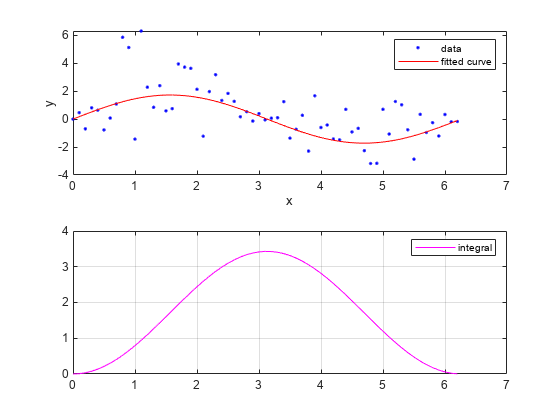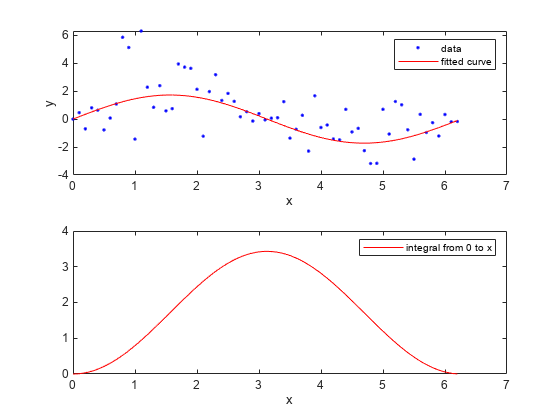integrate
Integrate cfit object
Description
Examples
Find the Integral of a Fit Using the integrate Function
Create a baseline sinusoidal signal.
xdata = (0:.1:2*pi)'; y0 = sin(xdata);
Add response-dependent Gaussian noise to the signal.
noise = 2*y0.*randn(size(y0)); ydata = y0 + noise;
Fit the noisy data with a custom sinusoidal model.
f = fittype('a*sin(b*x)'); fit1 = fit(xdata,ydata,f,'StartPoint',[1 1]);
Find the integral of the fit at the predictors.
int = integrate(fit1,xdata,0);
Plot the data, the fit, and the integral.
subplot(2,1,1) plot(fit1,xdata,ydata) % cfit plot method subplot(2,1,2) plot(xdata,int,'m') % double plot method grid on legend('integral')

You can also compute integrals and plot them directly with the cfit plot method:
figure
plot(fit1,xdata,ydata,{'fit','integral'})
The plot method, however, does not return data on the integral.
Input Arguments
fun — cfit function
cfit
Function to integrate, specified as a cfit
object.
x — Integration points
numeric vector
Points at which to integrate the function, specified as a numeric vector.
x0 — Lower bound for integration
numeric scalar
Lower bound for integration, specified as a numeric scalar.
Output Arguments
int — Integration results
numeric vector
Result of the integration, returned as a numeric vector of the same size as x.
Version History
Introduced before R2006a
Open Example
You have a modified version of this example. Do you want to open this example with your edits?
MATLAB Command
You clicked a link that corresponds to this MATLAB command:
Run the command by entering it in the MATLAB Command Window. Web browsers do not support MATLAB commands.

Select a Web Site
Choose a web site to get translated content where available and see local events and offers. Based on your location, we recommend that you select: .
You can also select a web site from the following list:
How to Get Best Site Performance
Select the China site (in Chinese or English) for best site performance. Other bat365 country sites are not optimized for visits from your location.
Americas
- América Latina (Español)
- Canada (English)
- United States (English)
Europe
- Belgium (English)
- Denmark (English)
- Deutschland (Deutsch)
- España (Español)
- Finland (English)
- France (Français)
- Ireland (English)
- Italia (Italiano)
- Luxembourg (English)
- Netherlands (English)
- Norway (English)
- Österreich (Deutsch)
- Portugal (English)
- Sweden (English)
- Switzerland
- United Kingdom (English)